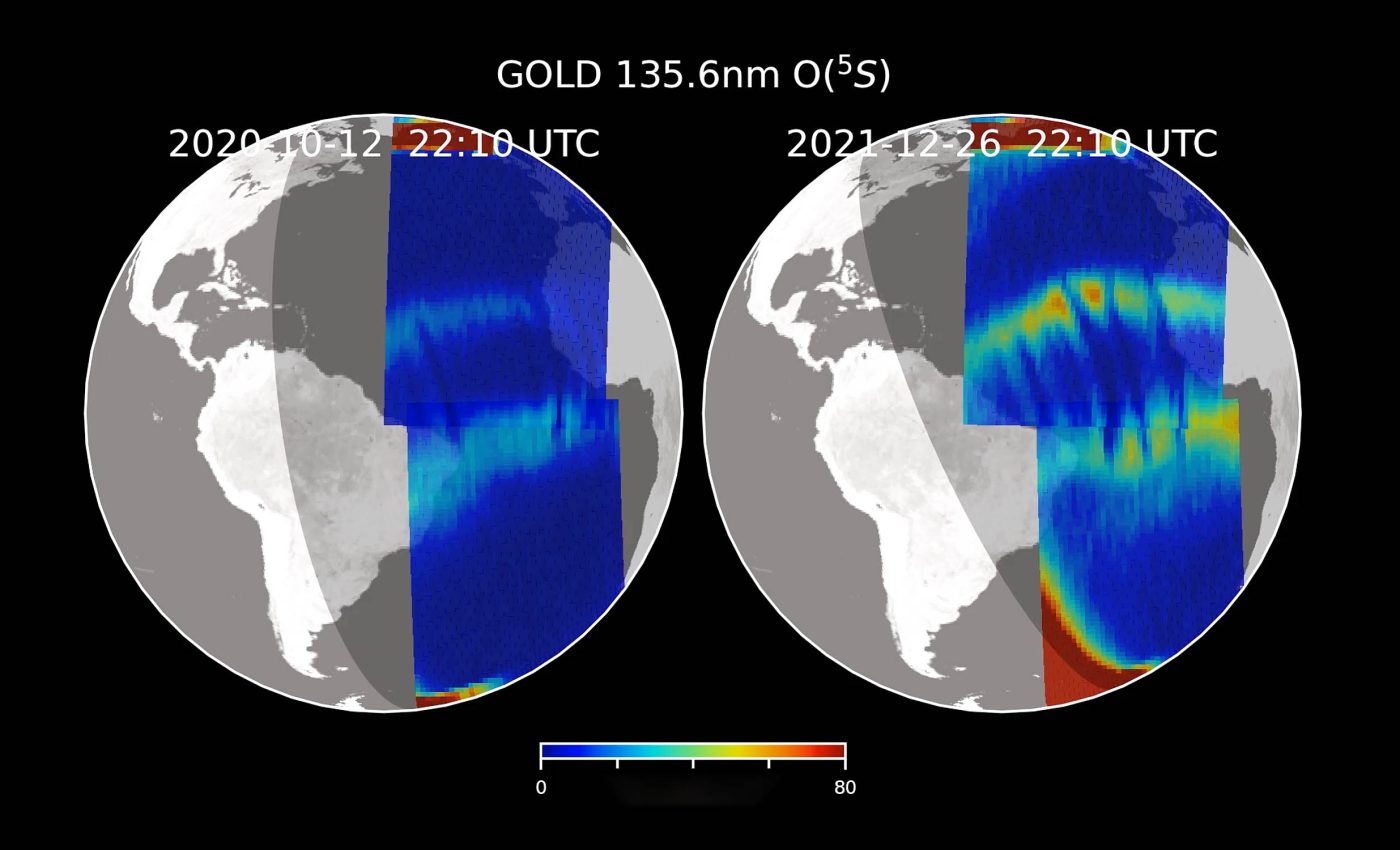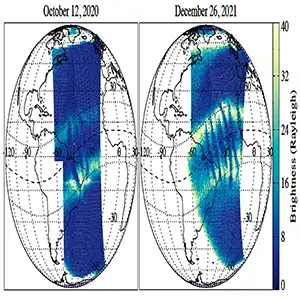
NASA unexpectedly finds 'X-shaped structures' in Earth’s upper atmosphere, which they can’t fully explain
Signals from navigation satellites, radio broadcasts, and distant spacecraft all squeeze through a thin, electrified veil in Earth’s atmosphere called the ionosphere. Stretching from about 50 miles to nearly 400 miles up, this region bristles with charged particles set loose by daylight.
After sunset, that energy settles, but not always in the tidy pattern engineers expect. A new set of nighttime snapshots shows the plasma folding itself into unexpected letters of the alphabet – and that spelling lesson matters for everyone who relies on an accurate map or clear call.
Most evenings, two broad ribbons of extra-dense plasma form on either side of Earth’s magnetic equator. Together they make the Equatorial Ionization Anomaly, a feature first charted in the 1940s and long blamed for after-dark radio static.
The bands usually stay parallel like lanes on a highway. Yet recent images from NASA’s Global-scale Observations of the Limb and Disk (GOLD) satellite reveal that the lanes sometimes twist, mingle, and collide without warning.
GOLD finds X shapes
GOLD was launched in 2018 and is parked in geostationary orbit, hovering above the Western Hemisphere. Its ultraviolet camera keeps a constant watch on the ionosphere’s nighttime glow, offering a movie instead of a snapshot.
That continuous view helped researchers led by Fazlul Laskar at the University of Colorado’s Laboratory for Atmospheric and Space Physics (LASP) spot a striking crossover pattern they call the EIA-X.
“Earlier reports of merging had appeared only during geomagnetically disturbed conditions – so its presence during geomagnetically quiet conditions was unexpected,” said Laskar, whose team detailed the findings in a comprehensive study published in JGR.

Computer simulations back up the X shapes that GOLD saw. When winds in the upper atmosphere slide downward over the magnetic equator just before sunset, they can shove the twin crests toward each other.
The meeting point seen by GOLD lights up as an X. Simulations also hint that waves rising from lower layers of air lend an extra nudge, showing once again that weather near the ground can echo all the way to space.
When quiet skies turn chaotic
The ionosphere is famous for mood swings during solar storms, but GOLD surprised scientists by catching the X shapes on nights when the Sun was calm.
“The X is odd because it implies that there are far more localized driving factors,” said Jeffrey Klenzing, a physicist at NASA’s Goddard Space Flight Center who was not part of Laskar’s modeling team.
Detecting an X during a lull means forecasters must pay closer attention to subtle tides and winds bubbling up from the troposphere and stratosphere, not just flares erupting 93 million miles away.
EIA-X episodes do not last long. They blossom after dusk and fade toward midnight, but while active they can bend radio waves enough to throw off a GPS fix by more than a few dozen feet – an error that matters to a surveyor, an oil tanker, or a precision-guided tractor.
X marks equator on GOLD satellite
Tracking these brief crossovers requires wide-angle coverage. Because GOLD spins with Earth, it records the same longitude continuously and can watch the EIA-X blossom over South America for hours at a stretch.
That window showed that the crossover sometimes stretches thousands of miles east-to-west before dissolving.

At other times it stays confined to a single time zone, hinting that several different atmospheric recipes can cook up an X.
“It’s a little like a tree growing in a windy area,” explains Klenzing. Wind direction changes with height, while magnetic field lines act like guy wires, shaping the plasma just as gusts bend a sapling.
Curious curves, mystery winds
GOLD also discovered plasma bubbles that curve into C-shapes or reverse-C-shapes instead of running straight along magnetic field lines.
“Such closely spaced, opposite-shaped plasma bubbles had never been predicted or imaged before,” said Deepak Karan of LASP, who reported the odd pairing in November 2023.
The team saw a normal C and a mirror-image reverse-C only about 400 miles apart – roughly the drive from Baltimore to Boston. That distance is tiny by ionospheric standards.
Winds that strengthen with altitude appear to sculpt a forward C, while winds that weaken carve the reverse. Having both shapes side by side suggests that whirling vortices or fierce shear layers lurk in the upper atmosphere.
“The fact that we have very different shapes of bubbles this close together tells us that the dynamics of the atmosphere is more complex than we expected,” Klenzing said.
And the stakes are high: “It’s really important to find out why this is happening,” Karan said. “If a vortex or very strong shear forms in the plasma, it can completely distort that region. Signals will be lost completely with a strong disturbance like this.”
Alphabet matters down here
Pilots, emergency responders, and power-grid operators all rely on forecasts of space weather. An unexpected X or C in the ionosphere can enlarge positioning errors, garble high-frequency radio, and even trip protective relays in long transmission lines.
Because GOLD spots these shapes in real time, engineers may soon receive alerts that flag vulnerable regions before signals stray.
The mission’s data feed also helps scientists refine computer models that drive tomorrow’s space-weather bulletins.
Future missions to figure out X events
Only two close C-shaped pairings and a handful of X events have appeared in GOLD’s catalog so far, yet each one pushes researchers to widen their search.
New missions such as NASA’s upcoming Geospace Dynamics Constellation will add low-Earth-orbit perspectives, offering a 3-D look at plasma motions.
Combined with ground-based radars and all-sky cameras, those views promise to turn today’s alphabet soup into tomorrow’s readable forecast – a forecast that could keep your next GPS route on the right road and your next phone call crisp and clear.
The full study was published in the journal Journal of Geophysical Research: Space Physics.
—–
Like what you read? Subscribe to our newsletter for engaging articles, exclusive content, and the latest updates.
Check us out on EarthSnap, a free app brought to you by Eric Ralls and Earth.com.
—–













